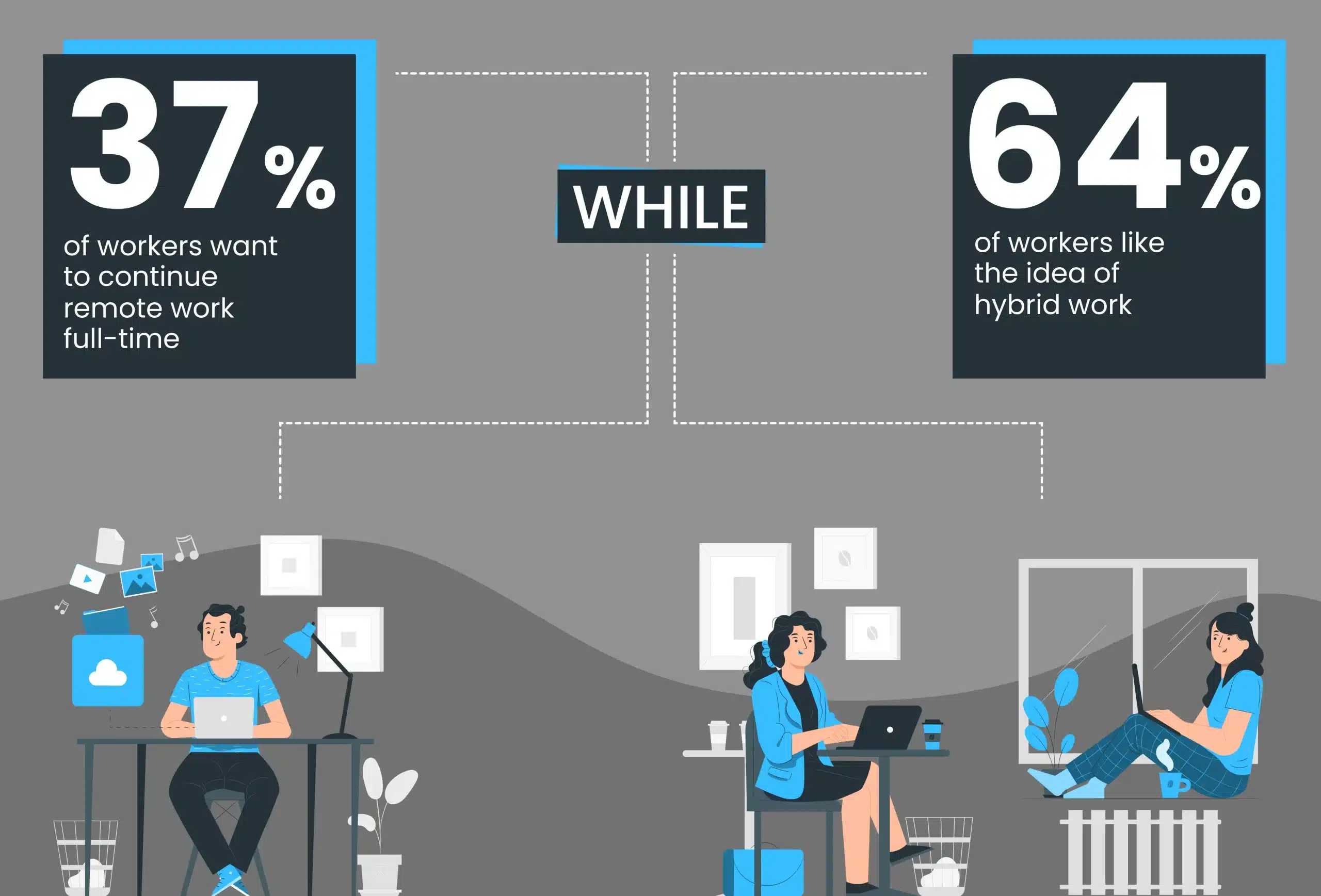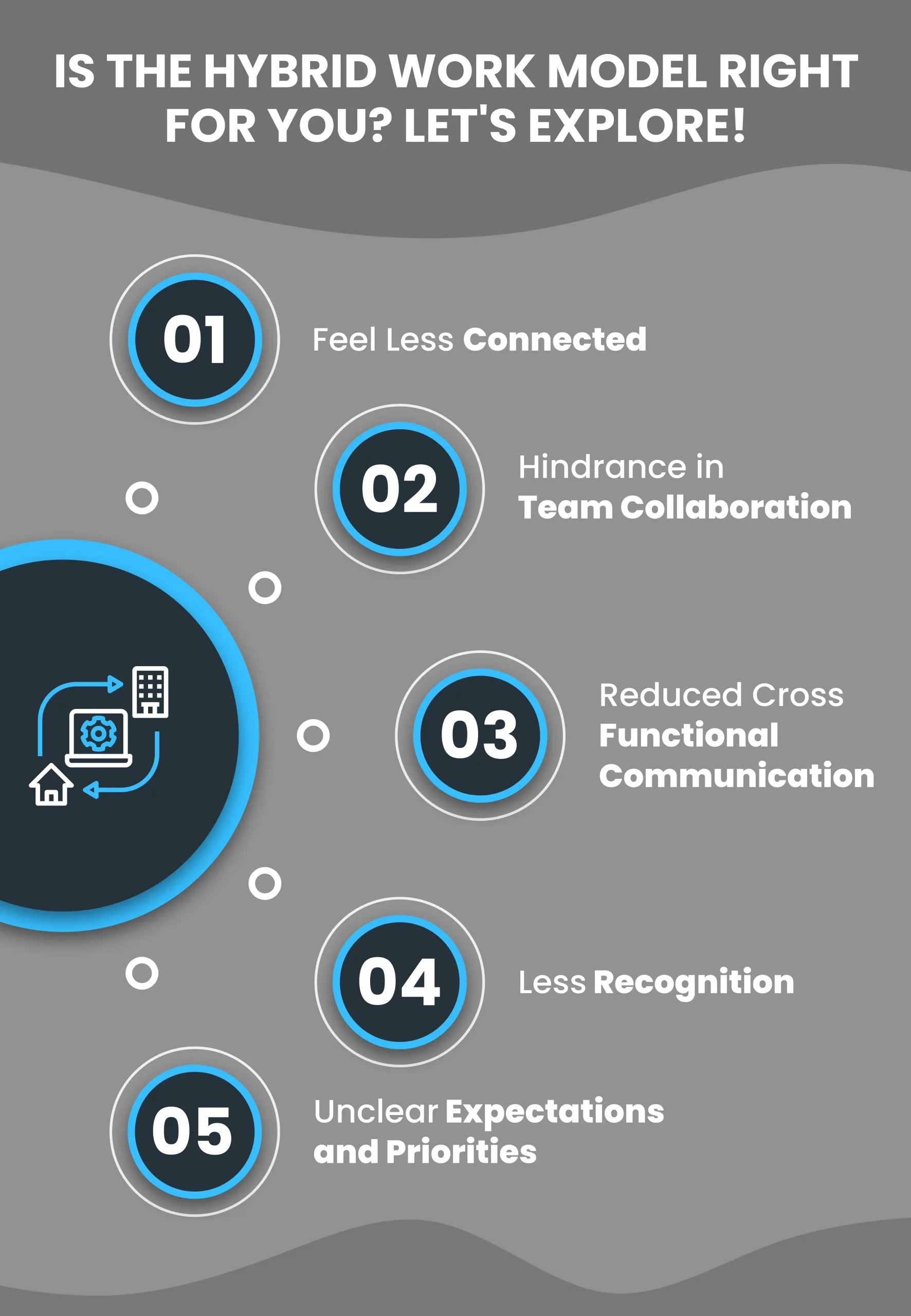Table of content
How a Hybrid Work Model is a Win-Win for Your Team?
The hybrid work model has numerous benefits for both employees and employers. In this section, we have listed some of the significant advantages of this new work arrangement. So, read on to discover how your team can benefit from it.
Increases Productivity and Efficiency
A study by the University of Birmingham found that 76.5% of employees believe flexible work increases productivity. Flexible work options can lead to better work-life balance, higher job satisfaction and motivation, and increased efficiency. Employers can create a more dynamic and engaged workforce by providing flexible working options, resulting in tremendous success for both the organization and its employees.
Low Operating Costs
The hybrid work model can significantly reduce operating costs for businesses. With fewer employees in the office, companies can downsize their office space, which means lower real estate costs and reduced need for office supplies such as paper and printer ink. This translates into lower operating costs, allowing businesses to allocate resources more effectively.
No Limitation in Recruitment
The hybrid work culture has emerged as a game-changer for businesses worldwide. By offering employees the flexibility to work from home or the office, companies can attract and retain top talent from anywhere in the world. This eliminates recruitment limitations and promotes diversity and inclusivity in the workplace. A more diverse workforce brings in new ideas and perspectives, which leads to more incredible innovation and creativity. This, in turn, results in a more skilled and productive workforce, thereby leveling up a team’s potential. Adopting a hybrid culture can benefit businesses in many ways, including increased employee satisfaction, lower costs, and higher productivity.
Better work-life balance
The hybrid work culture provides employees with a better work-life balance, increasing productivity and engagement. By offering the flexibility to work from home or the office, employees can better manage their personal and professional responsibilities. This leads to less stress and burnout, reducing negative impacts on both work and personal life. Additionally, reduced commuting time and costs allow for more time with family and individual pursuits, resulting in a more fulfilled and satisfied workforce. Ultimately, this translates into better business outcomes.
Employee Retention
Another advantage of the hybrid work model is employee retention. It helps maintain high levels of employee satisfaction, which can significantly impact a business’s growth and success. It fosters a positive work environment, builds a strong team, reduces employee turnover, and increases productivity. When employees are happy and satisfied with their jobs, they are less likely to seek employment opportunities elsewhere, reducing recruitment and employee turnover cost.
Let’s Explore Potential Challenges of Hybrid Work Model!
Before implementing the hybrid work model, it’s essential to consider potential roadblocks, including communication barriers, technology infrastructure, and managing remote employees. With proper planning and communication, these challenges can be overcome. Let’s take a closer look at them.
Feel Less Connected
When working remotely, feeling less connected with your team is common. With the opportunity to interact in person, it can be easier to maintain the same level of communication and collaboration that you’re used to in a traditional office setting. Additionally, you may miss out on social interactions and team bonding activities that help build relationships and strengthen connections.
Hindrance in Team Collaboration
Feeling less connected when working remotely can also negatively impact team collaboration. When you’re not in the same physical location as your team members, it can be harder to coordinate tasks and projects, leading to delays and miscommunications. It can also be challenging to brainstorm and problem-solve collaboratively when you’re not able to bounce ideas off of each other in real-time.
Reduced Cross-Functional Communication
Reduced cross-functional communication can cause challenges in the hybrid work model. Remote workers may feel left out of important conversations, leading to departments and teams working in silos. Organizations can overcome this challenge by providing remote workers with tools to communicate and collaborate effectively, offering cross-functional training, and fostering a culture of open communication. Breaking down silos and improving collaboration can lead to more effective decision-making, faster problem-solving, and better overall performance, even in a hybrid work environment.
Less Recognition
When working remotely, it can be easy to feel disconnected from the rest of the team and the company. One potential consequence of this is that remote workers may receive less recognition for their contributions compared to those who work in the office.
One reason for this is the hierarchical structure of many companies, where those physically present in the office receive more attention and recognition from management simply because they are more visible. Remote workers who are not physically present may be overlooked or forgotten, even if they are doing great work.
Unclear Expectations and Priorities
The hybrid work culture can lead to clarity and team communication, achieving more precise expectations and priorities. This can make task management challenging and lead to inefficiencies. Organizations should establish clear communication protocols to mitigate these challenges, regularly communicate expectations and priorities, and ensure that team members understand their roles and responsibilities. By doing so, organizations can reduce confusion, improve task management, and achieve better performance.
How Supersourcing Can Help You in Implementing a Hybrid Work Model in Your Organization?
This model allows employees to work from home while still maintaining some level of face-to-face interaction with their colleagues. The hybrid work model has its own advantages and challenges. While it provides flexibility and better work-life balance, it can also create communication and management challenges.
If you’re planning to implement a hybrid work culture in your organization, you’ll need help from the experts. Supersourcing can be your go-to partner for this. We help you connect with top IT professionals who are experienced in working in any kind of work culture.
So, if you’re looking to implement a hybrid work culture in your company, get in touch with us today.




